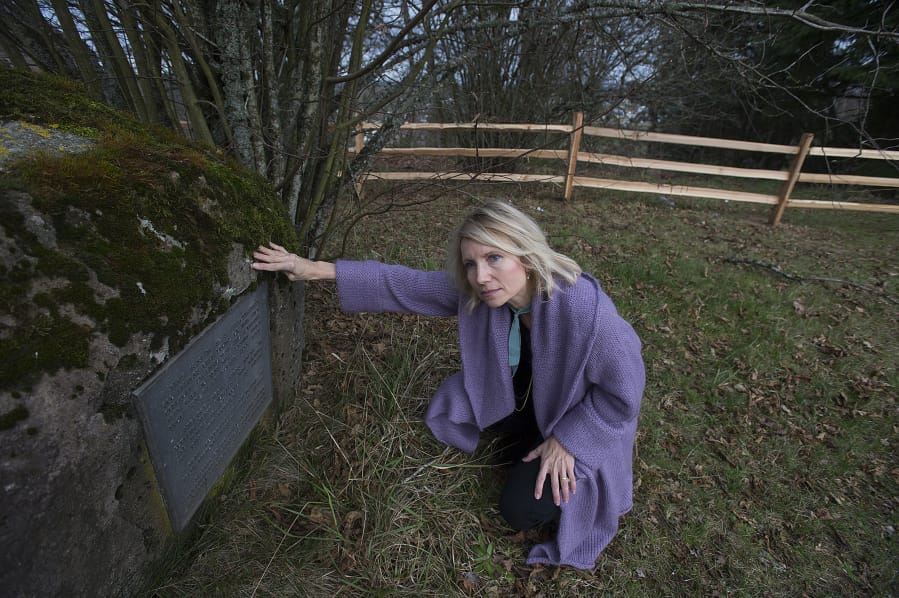On a grassy field in the 78th Street Heritage Farm, Lisa Bayautet knelt next to a stone bearing a weather-beaten plaque. The plaque describes how the approximately 200 people buried on this plot between 1873 and 1935 overcame “misfortune and adversity” before coming to their final resting place at the Clark County Poor Farm.
“Although their lives ended in poverty, these pioneers raised families and toiled in the woods and fields to build the country,” the plaque reads.
Many came from far away, spent their last years in poverty as people society was content to forget ever existed. Bayautet, who lives next door to the cemetery, said these people don’t have family members around to preserve their memory. Now she’s worried about their remains.
The poor farm cemetery is part of the 78th Street Heritage Farm, which is owned and managed by Clark County. Currently, the farm is updating its master plan, which includes building trails, a children’s garden, a learning center and parking lot near the cemetery.
County and state officials said they’ll take precautions to prevent any remains from being desecrated. But Bayautet said she suspects that there are people and artifacts buried elsewhere on the farm, and she worries those sites will be disturbed as the master plan is carried out.
“I feel like I’m kind of a protector of people here,” said Bayautet.
According to the county’s website, the county began operating the poor farm in 1873 as a place where indigent individuals lived and worked raising their own crops and livestock. It operated until 1943, when the county negotiated a lease with then-Washington State College to convert 28 acres of the property into a research and experimental farm. Now, the county owns the farm and operates it in partnership with Washington State University.
“There wasn’t welfare in those days, and the county created the poor farm to take care of some of those people,” said Rose Marie Harshman, a longtime member of the Clark County Genealogical Society, who’s conducted research on the farm.
In 2001, she and two other researchers completed a book on the poor farm that attempted to document who is buried there. The book states that they couldn’t find an official list of everyone who lived and died at the farm and relied on obituaries, old newspaper accounts, funeral home records and death certificates.
The book details the lives and deaths of those buried in the plot. Almost all came from across the county (or another country). Most died from disease. A few from suicide. Some were unidentified. Several were killed by trains, which could be a sign they were transients trying to catch a ride.
Fenced in
In January, the county, using a Historic Preservation Grant, placed a split-rail fence around the 300-by-150-foot cemetery plot, replacing a chain-link fence that previously divided it.
Bill Bjerke, Clark County parks manager, said the county hired a contractor to produce a ground-penetrating radar scan of the area to find out what’s beneath the surface. He said that the old fence divided the footprint of the cemetery, which he said made no sense, and that the new fence demarcates its actual footprint.
“The importance of demarcating it is so folks in the future know where it is and won’t desecrate any graves,” he said.
Bayautet said that records from that era are murky and don’t account for specific locations of bodies, and she suspects that some are buried outside of the plot. She said that some families of the deceased may have been too embarrassed to put them in the poor farm cemetery or not have wanted to pay burial fees. Instead, they may have wrapped them in blankets and buried them nearby in the middle of the night, Bayautet said.
“I think it gives a false idea that all these people are right in here,” said Bayautet of the new fence.
Harshman said there were only two grave markers found on the site. There’s a marker in the cemetery plot for Elias Koser, who was a laborer on Prune Hill before succumbing to gangrene in 1929.
The other marker belonged to Lee Anderson, who the book said died in 1932 (it doesn’t specify what from). Descendants of Anderson currently have the marker. But it was found in the wooded area on the hillside just north of the plot, said Harshman. Bayautet said the location of Anderson’s marker is evidence that there are bodies outside of the cemetery plot.
“I absolutely believe there are people in the woods,” said Bayautet.
In her research, she also found an old map of the cemetery plot that seems to suggest that rows of graves extend into a neighboring field. She also said that past ground-penetrating radar scans suggest that there are burials beyond the cemetery’s footprint.
Allyson Brooks, state historic preservation officer with the state Department of Archaeology and Historic Preservation, said that there is “no real controversy” here.
She said that when the new fence was being built, there was an archaeologist monitoring the back dirt and making sure that no human remains were dug up. If there had been, she said, the work would have stopped. In a follow-up email, she said that the same monitors will be present for future construction. An old metal gravestone marker was found and is in possession of the Clark County Historical Museum, said James Kice, its collections manager.
Bjerke said there’s a buffer from the cemetery and that there will be a monitor on hand when they do disrupt the ground for permanent structures. But he added, “It’s hard to know what’s under the ground for the whole farm.”
In the meantime, Bayautet said she’ll be watching.




